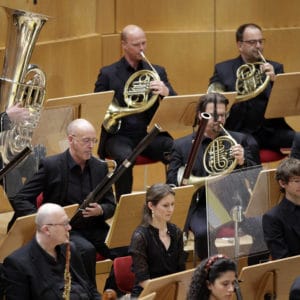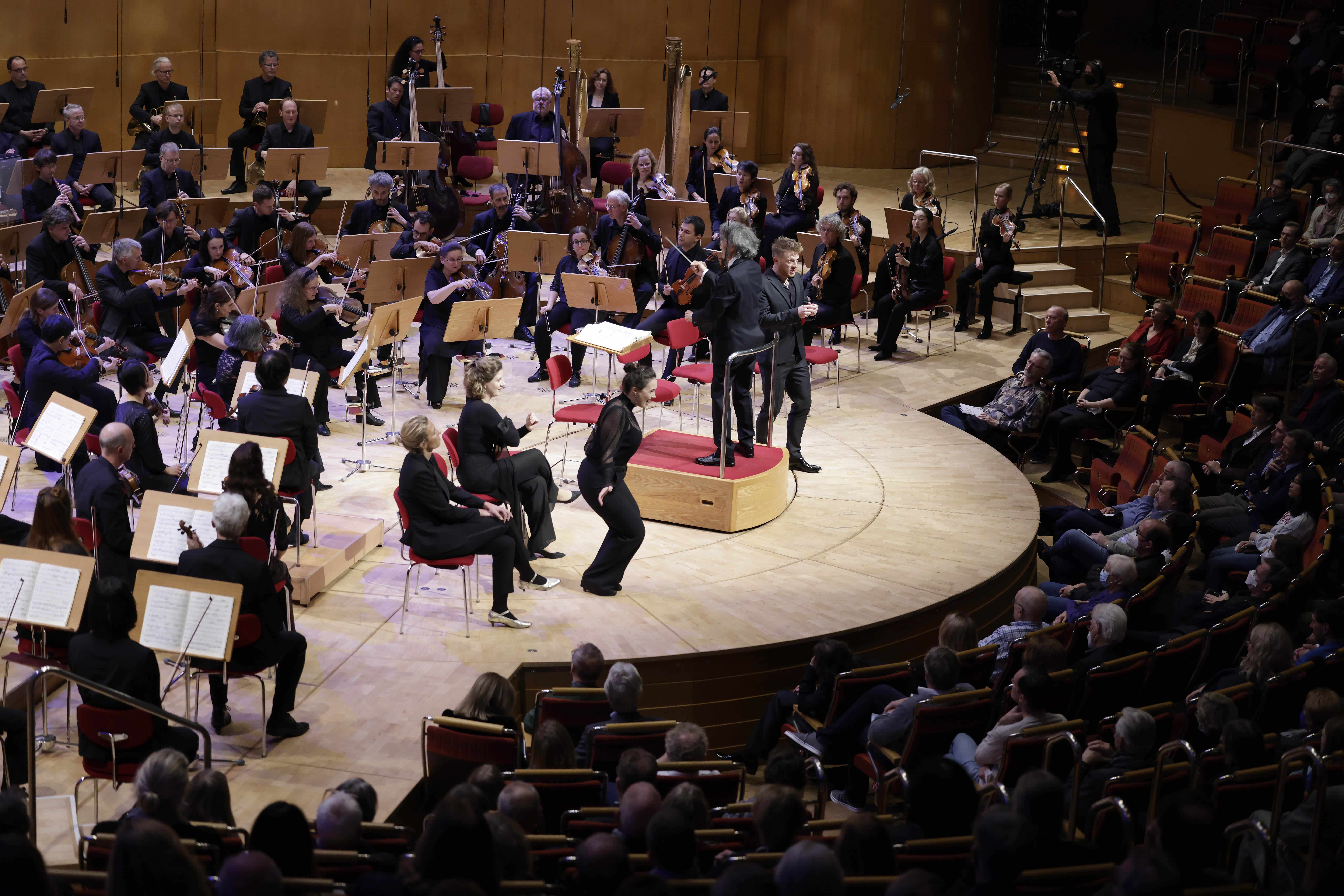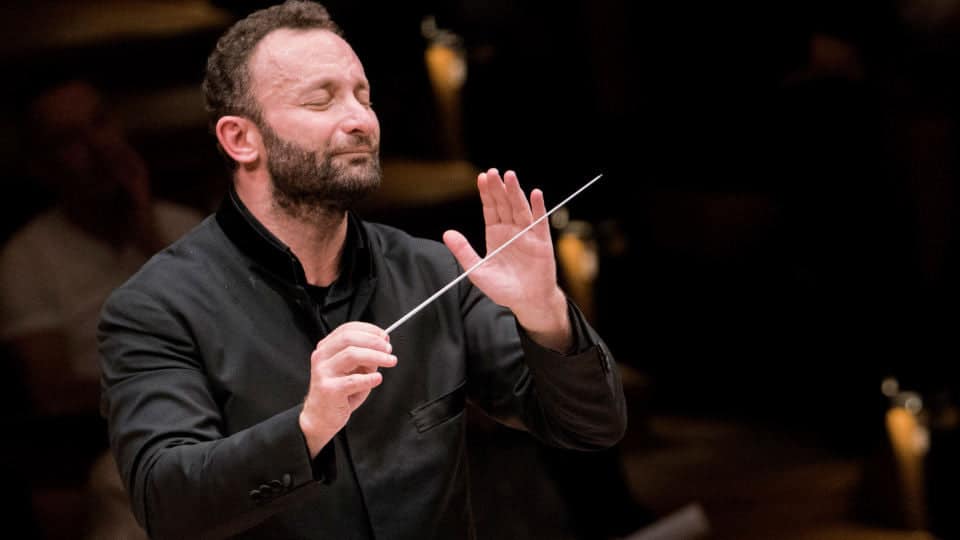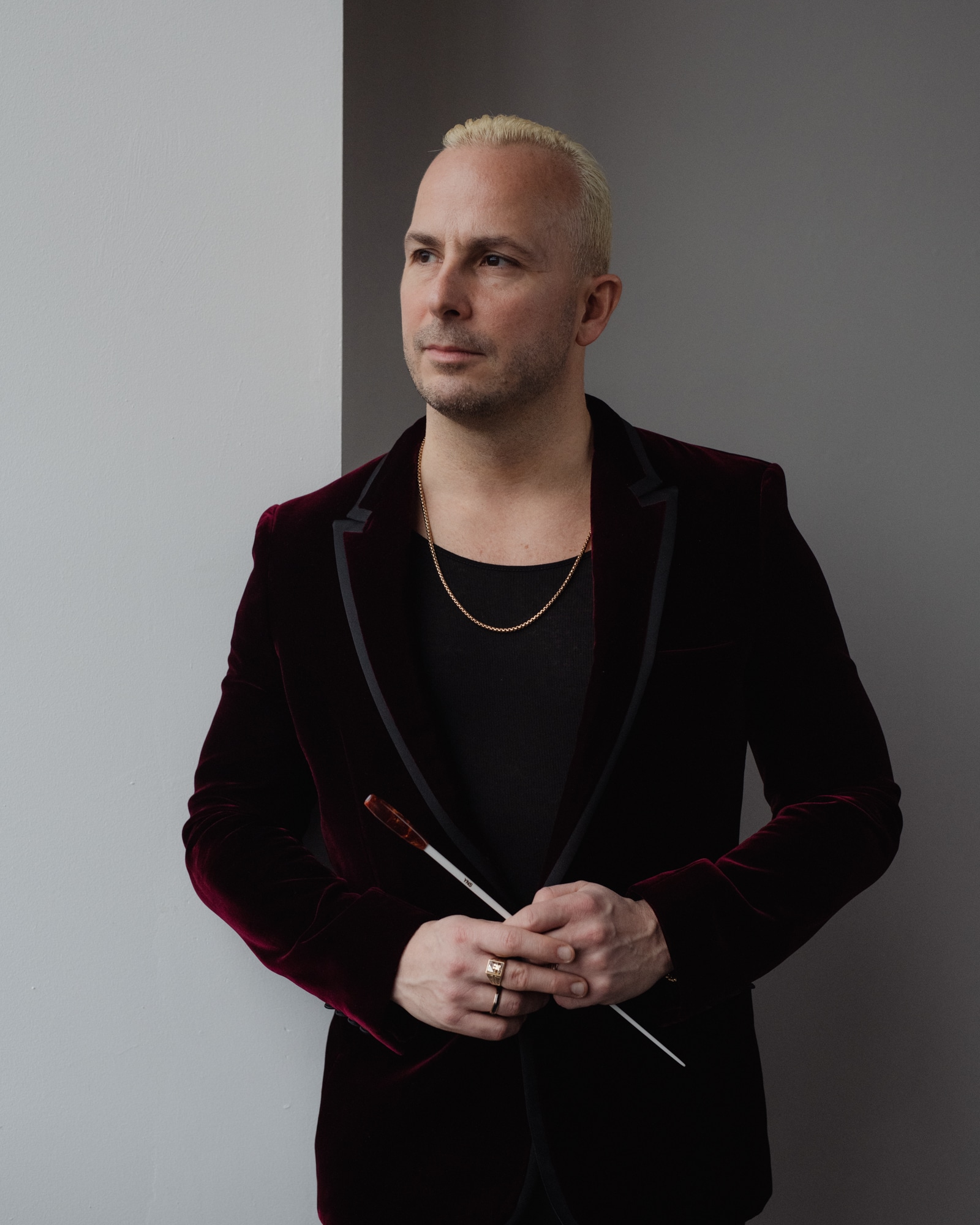The Ring on period instruments – it’s a significant difference: First review
NewsShirley Apthorp reports exclusively for Slipped Disc on last night’s HIP Rheingold in Cologne:
DAS RHEINGOLD – Philharmonie Köln
by Shirley Apthorp
It began as a joke. After a concert with Kent Nagano, a musician from the specialist early music ensemble Concerto Köln asked Kent Nagano, “When are we going to do Wagner’s Ring together?”
After five years of planning, research, instrument-building, fund-raising and rehearsal, the Ring project was launched with Das Rheingold on Thursday evening at the Cologne Philharmonie. With this first-ever modern-day Rheingold on original instruments, it became clear that Concerto Köln’s Wagner is no joke. The 20-member ensemble has padded itself out with colleagues to full Wagnerian size, and worked with fanatical attention to detail.
From the first low rumble, it is clear that Wagnerian period instruments offer a glimpse of another universe. Gut strings and a background in historical performance mean a string sound that is more woody, more mellow, and infinitely more articulate than today’s. Players accustomed to the precise articulation of baroque music bring a refreshing clarity to the attack of individual notes. It is as if a string of shapeless vowels have suddenly acquired consonants, making language from what used to be just sound. The gut also changes the implications of playing without vibrato – instead of bare and slightly shrill, as it can be with metal-wound strings, it is soft and warm.
Wagner disliked the cor anglais, preferring the alto oboe. He used bass clarinets in A and B, and clarinets in C, which have long since fallen into disuse. Orchestral pitch was 435, significantly lower than today’s 440-443. The brass instruments of his time – including the famous Wagner tubas – have more bite, and sound more growly. The wooden flutes and muted horns both provide a veiled, otherworldly tone colour.
In all, the differences are significant. Nagano, taking Wagner’s metronome markings as his guide, chooses tempi which are sometimes breathtakingly fast, and occasionally arrestingly slow (though in the latter case, most noticeably when Erda appears, that may be driven by the singers’ choices).
An academic research team has worked on the question of “authentic” Wagnerian singing for the project, with a focus on clear enunciation and expressive gesture. The former has mostly paid off. The projected surtitles seemed like a declaration of poor faith; and indeed, it was possible to understand almost every word without them.

The cast is excellent. Daniel Schmutzhard is so expressive and compelling that you think, “This opera is really about Alberich!” Derek Welton sounds so fresh and sings with such warm intelligence and refinement that you think, “This opera is really about Wotan!” And then comes Thomas Mohr, stepping in at the last moment to replace Julian Prégardien as Loge, equally making the opera his – and, interestingly, just as clear in his text and pithy in his expression as those who have worked with the research team. Clearly experience in the modern world does count for something.
Nagano’s direction is crystal clear and exquisitely structured. Sometimes you yearn for a little more unfettered wildness, a little more metric freedom, a little less sobriety; but you can get those things elsewhere.
The “Wagner-Lesart” team of academics working on the project have delved into the world of 19th-century gesture. This aspect translates the worst to today’s concert stage, not least because the singers have taken it on board erratically. The Rhinemaidens seem about to break into the Village People’s YMCA; they are also the ones who make the most use of a kind of melodramatic speech used to replace song, which sounds more like Schoenberg’s Pierrot Lunaire and sends the audience into titters. As Fricka, Stefanie Iranyi uses both arms like a marionette; Welton points meaningfully into the audience. The event is billed as semi-staged, but this is something of a misnomer. Historically informed stagings are a minefield, often paralytically boring, sapping the subtext from the work, turning something conceived as cutting-edge theatre into a museum piece. This performance is all about the music, and that is enough, even if that is only half of what Wagner can be.
Concerto Köln and Nagano stand on the shoulders of giants. Roger Norrington, Marc Minkowski, Thomas Hengelbrock and Hartmut Haenchen, to name just a few, have all done ground-breaking work in historically-informed Wagner performance; this new Ring is a continuation.
Nevertheless, it is a huge achievement for Concerto Köln, and a fascinating experiment.
The performance was filmed for online streaming; the date for its release has not yet been announced.

photos: Thomas Brill/Koelner Philharmonie
This is an initiative of the Köln Philharmonie and its intendant Louwrens Langevoort.






<>
Hang on, didn’t Rattle do Rheingold on period instruments a few years ago ?
Exactly, with the Orchestra of the Age of Enlightenment at the Proms in August 2004.
That would be this performance: https://youtu.be/CUFWNKFajjA.
Great performance & beautiful orchestral sound. And great singers.
Not just at the Proms. He and the OAE also performed it in Baden Baden.
The full performance from Baden Baden can still be seen on Youtube, so its a surprise that the reviewer seems to be completely unaware of Rattle’s and the OAE’s work in this field.
Yes but he might have used the cor anglais thereby invalidating the whole experience.
Rheingold is not the entire Ring, Jan.
Nagano might just be the ideal modern conductor for the job: an experienced Wagnerian, an extremely cerebral and intellectual student of scores, and very respectable in HIP (his Haydn, Mozart, and Bach with the OSM were all very good, for modern orchestras). I’m not surprised to see the project be a musical success.
This is exciting. From the previous post on SD, a lot of people were predicting the worst – apparently their worries were misplaced. I can’t wait to hear it myself! And a real Bass Clarinet in A! That’s dedication.
Was about to say the same thing about Rattle. “Is this new?” Or sensible, in truth? Can we get original singers and small theatres, as well? And an original conductor?
(I love “soffer…”. Is that “offer” or “suffer”?)
Also, what “metronome markings”? You mean legend, lore, and Porges?
It is well-known that Wagner stopped writing metronome markings, after his earlier works, when he found-out that they did not work in different citrumstances with different orchestras. Hence his much more general indications.
I look forward to hearing the Long Call played on a soprano recorder.
https://www.youtube.com/watch?v=D9XadihIPYg
The OAE played Das Rheingold at The Proms in 2004. Rattle conducted.
Weird, isn’t it? A Wagner orchestra seeks to become more authentic but, at the same time, Wagner productions avoid authenticity like the plague in the desperate search for “relevance”.
Indeed.
Period instruments ? Why not. But why on earth without vibrato ?
Exactly. Because Norrington and others have convinced us all that vibratoless string playing was the norm back then. I am far from convinced. Toscanini played for Verdi and was an adamant exponent of vibrato string playing for beauty of sound. Original wind instruments, yes, gut strings yes. No vibrato? Dubious at best. David Hurwitz among others have debunked this fiction very effectively. Plus it sounds pretty lame. Give me the Philadelphia sound every time!!!
It is well-known that before the 20th century, strings in orchestras used some vibrato but as an addition, not a wabbling sound as a point of departure. The violinist Joseph Joachim – who was a friend of Brahms and worked with him – wrote somewhere that vibrato is a form of ornamentation, so: addition, not an ingredient.
I can’t think of a single modern orchestra taking “a wabbling sound as a point of departure”. Poorly executed or excessive vibrato is frowned upon nowadays as it has always been (see Leopold Mozart’s Violinschule), with of course changing tastes about what is excessive. But no vibrato is plain idiotic.
And a single sentence of a star violinist is hardly evidence of anything at all about orchestral practice in his time.
Bass clarinet in B? You sure about that?
He didn’t write for bass clarinet in B, Bb in german is B as I’m sure most people here know, hence the confusion. He did write for bass in A which is pretty unusual but I do know there is at least one modern instrument in the UK. Also clarinets in C haven’t fallen into disuse, some C parts might be transposed onto the Bb or A by some players but a C part like that in Arabella would definitely be played on the C.
Glerb:
B in Germanic is B flat in English, yes.
H:Dur = B Major. B:Dur = B flat Major.
It’s a century-old linguistic confusion.
Also, if you want to be really authentic, you wouldn’t use Wagner tubas. They almost certainly weren’t ready for the first performances of Das Rheingold and Die Walküre.
I’m sorry, I must have fallen asleep. What were we talking about?
“ Orchestral pitch was 435, significantly lower than today’s 440-443.”
I don’t consider that very significant. Many Baroque groups tune to 415 which is noticeable. I prefer 438 to 440+ but the sound is right under my ear.
I would suggest that the gut strings are a more significant factor.
Kent Nagano is an excellent conductor. I look forward to seeing the video.
The Ring in a “faithful periodic” style? Like what? Like Hans Richter conducted it in August 1876?
Last I checked, Meister Richard was outmost dissatisfied with Hans Richter’s conducting…
Great coverage… except one, of the most important HIP aspects was not specifically mentioned!!!
The metal “E” string on modern violins is a 20th-century innovation, and it really defines the sound of modern violins. Not only directly, when played upon. Also indirectly, by influencing the harmonic behavior of the instrument as a whole.
In Wagner’s era, violin “E” strings were usually silk (and sometimes gut). While steel strings did exist, they were for impoverished street or café fiddlers.
Two things put paid to silk “E” strings.
First, large naval artillery of the late 19th/early 20th centuries used silk bags to hold the charges of gunpowder (rather than brass shell casings). Therefore, with the outbreak of WWI and the interruption of supply chains, there was a scarcity of silk. All available silk supplies were diverted to the war effort.
Furthermore, when violinists, of necessity, began playing on steel strings, it quickly became apparent that steel strings had much more “cut” when making recordings than silk strings were capable of.
Pre-electrical recording technology (meaning, pre-1926 or pre-1928 or thereabouts), recordings were made by using a horn acoustically to focus the airborne energy of the instrument (or voice) to move a diaphragm, which vibrated a needle, which inscribed a groove in wax or lacquer. Steel strings were not subtle in tone; but wow could they cut wax.
So, one assumes that the HIP orchestra under discussion here had done enough research to use silk violin “E” strings, or at least gut.
This subject was covered in an issue of “The Strad,” back circa 1978.
Back when I fooled around on the viola (mostly to make practicing the violin seem like the easier task), I used a gut “A” string, and I loved its sound as well as its feel.
There Arena no Metronom markings from Wagner for the Ring
It is possible that they have expanded from twenty players to the sixty-four strings and thirty-six odd woodwind and brass asked for in the score? I cannot quickly find details about the orchestra’s composition.
As several have already noted, there are no metronome markings in the Ring. Sounds like Ms. Apthorp wasn’t taught about that in Tasmania (or ever talked to musicians about the subject, let alone took a look at a score). That’s the kind of faux pas that makes statements by “HIP experts” problematic. I, too, would like to know how many strings were used. Because “authentic” means 20 1st violins (as in the Bayreuth pit). In the photo I count 3 double basses and 2 Harps – that’s about 7 missing basses and precisely 4 missing harps, if we are using what Wagner stipulated. I can see 5 cello (maybe there is sixth out of shot) – that’s be less than half the number RW decided to use in the pit specially built for the Ring. Citing Munich, by the way (Rheingold & Walküre world premieres) is not relevant, as those performances were expressly against the composer’s wishes. While there is nothing wrong with trying out period instruments, or even playing with a much reduced string section, doggedly calling this “authentic” while disregarding so many other factors is really just a publicity gimmick. And was there really vibrato-less string playing? More absurdity. And as for HIP string players bringing “refreshing clarity” to Wagner’s music because of the “precise articulation of baroque music” – I’d like to hear one of them practicing the Feuerzauber.
Wagner stipulated 8 basses for Bayreuth, not ten.
and in the Bayreuth pit basses and harps are placed in two groups at either side, violoncelli spanning the center in front of the woodwinds – just as in Nagano’s performance in Cologne (as a quick Google search for more pictures would have shown).
As far as I can tell, in this cologne performance there were 7 basses, 10 celli and 4 harps – in these times probably the closest you could get to the original numbers.
https://www.br-klassik.de/aktuell/news-kritik/210720-bayfestspielhaus-orchesteraufbau-100~_h-272_v-img__16__9__xl_w-483_-d14a9968b6314b64cbfb1fbee8edfee50e8c00e5.jpg?version=f4cf0
https://www.volkskrant.nl/cultuur-media/je-weet-niet-wat-je-hoort-richard-wagner-zonder-brulboeien-en-loeiend-orkest~b67944ac/
There were 5 harps in the Cologne production. 4 harps on stage, 1 backstage. The original score requires seven harps (6 on stage, 1 backstage).
No metronome marks in any editions, no, and he opposed to it. But we do have metronome markings that were noted during rehearsals, as well as general timings (apparently Rheingold should last no more than two hours). Nagano mentions this in the Volkskrant article.
And I just found another snapshot (on the website of “de Volkskrant”, a Dutch publication, from a rehearsal for the Concertgebouw performance). There are indeed 6 celli. So 3 basses, 6 celli – that’s about the size of the string section used in the so-called Coburger Fassung (published by Universal Edition). That version, of course, uses greatly reduced wind forces; Rheingold with a total of 54 players, Götterdämmerung with 63. But Universal never claimed “authenticity” – rather maintaining that this “Transkription” was useful for “middle sized orchestras” to have a playable version. The point, of course, is that the sound between strings and winds must be BALANCED. If there are more horns than celli (ENO) then balance is not an aim. (Or, if it is, it’s not gonna work.) – As for the much-vaunted claim of the gain in textual clarity, that is merely giving way to our present-day laziness in preparing for a visit to the opera house. In the 19th century libretti were studied, often for weeks, by theater lovers before going to a performance. That was why libretti were published. Demanding sung text to be as clearly understandable as it would be in spoken theatre is something stage directors often dream of, esp. if they have no operatic experience. Another misunderstanding. And using supertitles hasn’t exactly inspired more preparation, in our times. It merely reinforces the “consume an opera like a movie” attitude. Of course it does help when what takes place on stage has nothing to do with the music…
see my comment above:
in Cologne orchestra set up as in the Bayreuth pit with 2 groups of basses and harps at either side, celli in the middle:
4 harps, 7 basses, 10 celli
You are right, 8 basses asked for by RW. I don’t count 10 celli in the photo (Keulen, Netherlands, not Köln); I can see 8. The Bayreuth diagram you posted shows 20 first violins, by the way. And it shows 12 celli. The harps of Concerto Köln are indeed on both sides – 4 altogether, not the scored for 6 (again, see diagram). But perhaps the string number varied from venue to venue? As for “closest you could get in these times” I don’t see why 2 harps were left out. In any case it would be nice to get the official numbers for the strings used (not forgetting that non-vibrato reduces the sonority).
Have now done a google image search and I did find a pic with 10 celli! Interestingly, in that shot, all the basses are on the left, and the celli also. So they experimented, and (I suppose) settled on the Bayreuth seating later. Wonder who suggested it to maestro Nagano.
Yes, they should have used 7 harps (6 harps + 1 backstage) instead of 5 (4 harps + 1 backstage)!
Hm. Where would „backstage“ at the Kölner Philharmonie be…?
Oh, in the Kölner Philharmonie, they have placed the harp high, near the organ.
In the Concertgebouw it was backstage.
https://www.instagram.com/p/CWWLM5wg0d1/